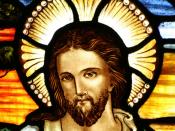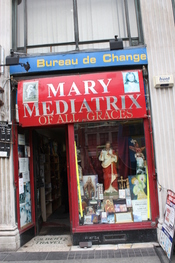Mary in the Modern World I In the doctrine about Mary there exist already four dogmae defined by the Church concerning Our Lady, a fifth marian dogma concerning her maternal mediation remains to be defined. We recognize that Mary, as the Mother of God, was disposed as a spiritual mother to cooperate in the grace and mediation of Christ in the functions of Co-Redemptrix and Mediatrix of All Graces. Her Co-Redemption was her activity in the acquisition of the redemptive graces of the Cross and her Mediation was her activity in the distribution of these redemptive graces.
Co-Redemptrix means literally, "ÃÂthe woman with the Redeemer', or, "ÃÂthe woman who redeems with the Redeemer'. We recognize that Mary participated with and under Jesus the Divine Redeemer in the acquisition of the graces of Calvary. Several sources in Scripture point to Mary's role of co-redemption. First is Genesis 3:15, where the woman shares in the victory of her seed over the offspring of the serpent.
Then in Luke 1:38 we recognize that by her fiat Mary already acts as a co-redemptrix in giving the Son of God His body. Since in the light of Hebrews 10:10, our salvation is through the offering of the Body of Christ once and for all, she is said to have at least a remote mediation in that she is the cause of the body of the Redeemer. In Luke 2:35 Simeon prophecies that a sword will pierce Mary's heart, foreshadowing Mary's active immolation of her son at Calvary. Then in John 19:26 we recognize that the act of the Redemption of man is tied to Mary, by her station with Jesus beneath the Cross. Also from Lumen Gentium of the Second Vatican Council we understand that shares in the intensity of His suffering through her motherly heart and that she consents in her heart to the immolation of the victim which was born of her. She actively consents to this immolation of her son in the depths of her heart and by means of the sacrifice of her maternal rights to preserve the life of her son.
Thus Mary is called co-Redemptrix in light of both the remote mediation of redemption by providing the Body of the Redeemer, our salvation, and proximately in the offering of her maternal rights at the foot of the Cross and active consent to the immolation of her son. Therefore Mary too merits for us the graces of redemption in a way that is at least decongruo, fitting, and possibly decondigno relativo, relatively in the order of grace (similar to Christ's meriting of redemption), as Pius X defined. Further, particularly in the writings of Pius XII we recognize that Mary is the New Eve, reversing the stain and sin of the first Eve with the New Adam.
Because Mary's role in redemption did not cease with her participation in the acquisition of the graces of redemption at Calvary, we recognize her role in the distribution of those graces in her role as Mediatrix of all Grace. Her role in objective redemption carries on into a role in the subject redemption of all people. Scripturally this is recognized at the Annunciation, Luke 1:38; in virtue of her fiat Mary mediates the Redeemer, the author of all grace, to the world. In the Visitation, Luke 1:42, Mary physically mediates the redeemer to John the Baptist in the womb of Elizabeth for his pre-sanctification. At Cana, John 2, we see Mary's moral mediation, a direct, willful request of Christ's assistance, in the first public miracle of Jesus, thus inaugurating His public ministry. Then in John 19:26-27 we see that Christ entrusts all of humanity to His mother and her motherly care. Thus John Paul II points out that Mary as a mediatrix places herself between her Son and mankind in the reality of its wants, needs and sufferings. Her mediation flows from her position as mother, not from outside the relationship of humanity and its Redeemer. Further in Lumen Gentium, the constant witness of the Holy See to Mary as the Mediatrix of all Grace, is specified to say that she is mother to us in the order of grace and that she is rightfully invoked as mediatrix. We understand that Mary is mediatrix of all the graces of redemption. Therefore all the graces flowing from Calvary forward to the end of time are mediated by Mary in terms of her moral mediation and possibly a physical mediation through her immaculate body. All the graces flowing backward to before Calvary are mediated by Mary in terms of her role in the final causality of those graces; that is by virtue of her role in the acquisition of the graces of redemption. As well during her life on earth, she mediated sometimes morally (Cana), sometimes physically( Visitation), and generally as final cause. Thus Mary is truly the Mediatrix of all the Graces of Redemption by virtue of her role in its acquisition and by the entrusting of all of humanity to her motherly care by her son.
II John Paul II treats of Mary's maternal mediation in his encyclical Redemptoris Mater. He shows that through her spiritual motherhood and cooperation in grace and mediation of Christ flows her maternal mediation and all her functions as co-Redemptrix, Mediatrix, and Advocate. Further he recognizes that in placing herself in between the need of humanity and her son she places her self in the middle of this relation, not as an outsider but through her position as mother. He points out that, as mother, Mary enters into the one mediation Christ in a way all hers own. Mary is present in the liturgy of the Church as mother, as the source of the Redeemer present in the Eucharist and as the subordinate cause of our redemption won on the Cross at Calvary which we receive in the sacraments of the Church. Above all we recognize Mary's maternal mediation in the filial entrusting of humanity to the mother of Christ. In this last, we recognize that Mary's motherhood is a gift which Christ makes personally to every individual, that when she was at the foot of the Cross, Christ entrusted humanity to Mary, and that the marian dimension of being a disciple of Christ is most perfectly expressed through an entrusting of the self to the mother of Christ. Such consecration to Mary is our way to model the beloved disciple and to take Mary into our homes, that is, our inner spiritual lives. This filial entrusting begins in Christ, with His words, and is directed to Christ, because Mary always leads us back to her son. In this light John Paul commends the consecration of de Montefort as the most effective means for Christians to live out their baptismal promises. We keep no part of ourselves but consecrate all to Mary and to Christ.





